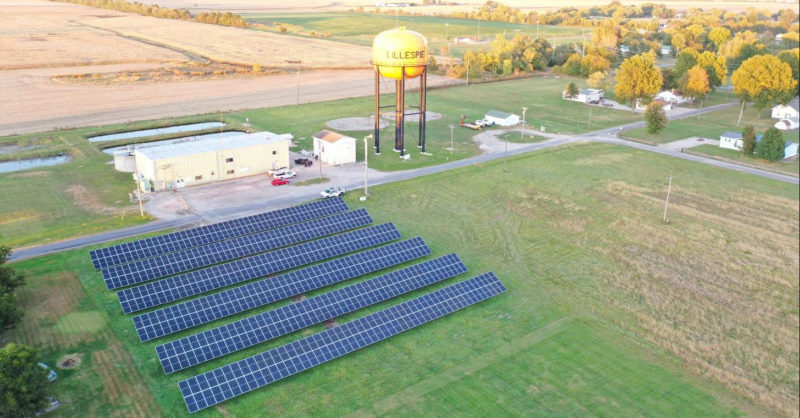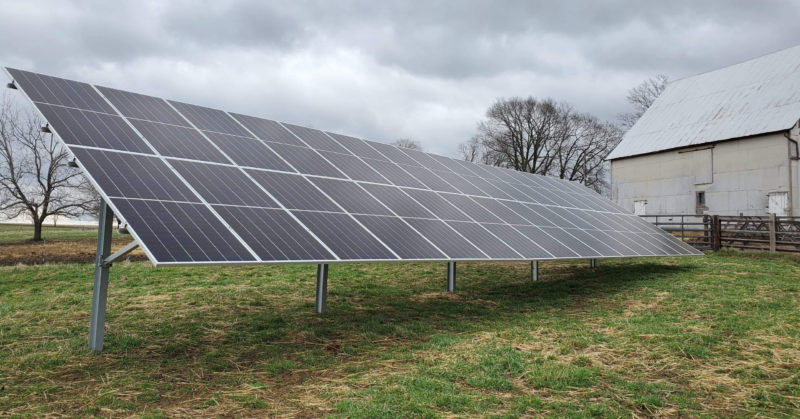By Amanda Pankau (updated 9/11/2023)
Solar energy is starting to shine on the Main Streets, courthouse squares, and small farms of rural Illinois. Solar energy brings many benefits to rural communities, businesses, and farms, including lower energy costs, well-paying jobs, revenue, grid stability, and cleaner air and water.

State and Federal Incentives for Solar
There are incentives available to make solar more affordable and beneficial for rural Illinois communities. Illinois’ Climate and Equitable Jobs Act (CEJA) boosted funding for solar, and created several new solar workforce and small business development programs. For instance, state Renewable Energy Credits (RECs) are available for most projects and provide 20 to 40% of a project’s costs, making solar development both more affordable for rural households and businesses and profitable for solar developers. Programs like community solar and Illinois Solar for All make solar more accessible to renters and low-income and environmental justice communities. And programs like “brownfield solar” help incentivize projects, like the solar project on the Urbana Landfill.
Clean energy investments from the bipartisan Infrastructure Investment and Jobs Act (IIJA) paired with boosted federal tax credits, thanks to the Inflation Reduction Act (IRA), further support the clean energy transition in rural communities. The solar energy tax credit is a 30% tax credit that can be claimed on federal income taxes for the cost of a solar system, and thanks to the IRA, the tax credit is newly available as “direct pay” to non-taxable entities, like municipalities. The IIJA and IRA are providing funding for electric school buses, clean energy demonstration projects in rural areas, smart grid improvements, funding for environmental justice communities, clean energy technology supply chains, and more. And for small rural businesses and agricultural producers, the IRA boosted funding for the Rural Energy for America Program (REAP), providing another opportunity for grant funding and loan financing for solar and energy efficiency improvements.
We shared more about many of these programs in our July 2023 Energy Transition Webinar Series.
Rural Solar Success Stories
On Monticello’s courthouse square, the Bespoke Gift Company recently installed solar on its 137-year old building. Small business owners, Tasha Dunaway and Jeff Zumwalt, first invested in energy efficiency upgrades before jumping into a rooftop solar project. Thanks to the benefits of state RECs, federal tax credits, accelerated depreciation, and a REAP grant, the project will pay for itself in less than 2 years. Inspired by the Bespoke project, farmers Wes and Sara Hornback of Sunset Acres broke ground on their farm’s solar project this spring. They’ve applied for a REAP grant as well and are excited to experience the economic and environmental benefits of their project!
Gillespie (pop ~3,000), a small town in southwestern Illinois and home to the Illinois Coal Museum, completed a 250kW solar project at their water treatment plant with an expected cost savings of nearly $50K per year and a 4-5 year capital cost payback. Community leaders also have their eyes on additional clean energy investments and are installing an EV charging station outside the coal museum. They plan to also take advantage of upcoming grants for additional charging station infrastructure in their community.

Prairie Rivers Network is working with rural Illinois communities to understand and reap the benefits of renewable energy policies and programs. We look forward to seeing renewable energy projects continue to blossom across Illinois, from Main Street to Shining Main Street.







